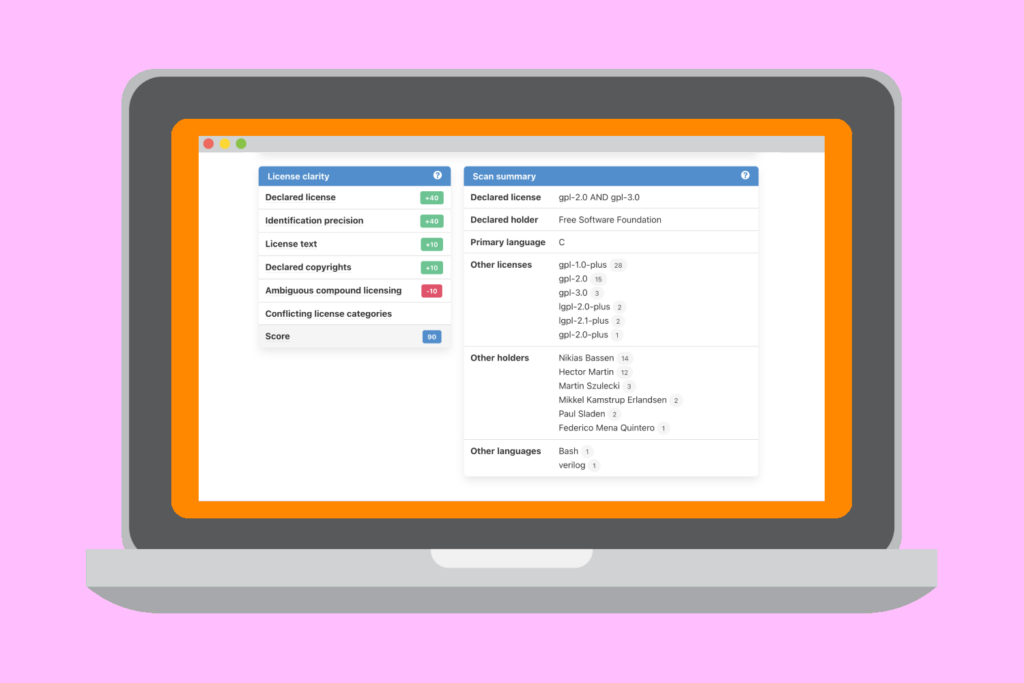When automating Software Composition Analysis (SCA) with a scanning tool, you need to quickly evaluate the results – especially to determine whether or not the results require a deeper investigation.
ScanCode now includes License Clarity Scoring to provide users with a confidence level regarding the automated scan results.
License Clarity is a set of criteria that indicate how clearly, comprehensively and accurately a software project has defined and communicated the licensing that applies to the project software. Note that this is not an indication of the license clarity of any software dependencies.
License Clarity Scoring in ScanCode uses that series of criteria to then rank how well a software project provides licensing information.

Declared License Expression
declared_license_expression is the primary license expression as determined from the declaration(s) of the authors of the package.
The new summary fields are:
declared_license_expressiondeclared_holderprimary_languageother_license_expressionsother_holdersother_languages
Note that the term declared_license_expression is used equivalently for the concept of a primary license expression in order to align with community usage, such as SPDX.
Here is how ScanCode determines the value for a declared_license_expression, primary_holder and primary_language of a package when it scans a codebase:
- Look at the root of a codebase to see if there are any package manifest files that have origin information.
- If there is package data available, collect the license expression, holder, and package language and use that information as the
declared_license_expression,declared_holder, andprimary_language. - If there are multiple package manifests at the codebase root, then concatenate all of the license expressions and holders together and use those concatenated values to construct the
declared_license_expressionanddeclared_holder. - If there is no package data, then collect license and holder information from key files (such as
LICENSE,NOTICE,README,COPYING, andADDITIONAL_LICENSE_INFO). Try to find the primary license from the licenses referenced by the key files. If unable to determine a single license that is the primary, then concatenate all of the detected license expressions from key files together and use that as a conjunctivedeclared_license_expression. Concatenate all of the detected holders from key files together as thedeclared_holder. - Note that a count of how many times a license identifier occurs in a codebase does NOT necessarily identify a license that appears in the (primary)
declared_license_expressiondue to the typical inclusion of multiple third-party libraries that may have varying standards for license declaration. It is possible that thedeclared_license_expressionconstructed by this process may not appear literally in the codebase.
As of DejaCode 4.2, you can also access the new license clarity scoring fields and summary fields in the Scan tab of the Package details user view.
When you scan a Package from DejaCode, you can view the Scan Results in a Scan tab on the Package details user view. DejaCode presents a selection of scan details with an emphasis on license detection. You can also download the complete Scan Results in .json format.
You can set the values from declared_license_expression, declared_holder, and primary_language to the package definition in DejaCode.

License Clarity Scoring
The license clarity score is a value from 0-100 calculated by combining the weighted values determined for each of the scoring elements: Declared license, Identification precision, License texts, Declared copyright, Ambiguous compound licensing, and Conflicting license categories.
Declared license (Scoring weight = 40)
When true, indicates that the software package licensing is documented at top-level or well-known locations (key files) in the software project, typically in a package manifest, NOTICE, LICENSE, COPYING or README file.
Identification precision (Scoring weight = 40)
Identification precision indicates how well the license statement(s) of the software identify known licenses that can be designated by precise keys (identifiers) as provided in a publicly available license list, such as the ScanCode LicenseDB, the SPDX license list, the OSI license list, or a URL pointing to a specific license text in a project or organization website.
License texts (Scoring weight = 10)
License texts are provided to support the declared license expression in files such as a package manifest, NOTICE, LICENSE, COPYING or README.
Declared copyright (Scoring weight = 10)
When true, indicates that the software package copyright is documented at top-level or well-known locations (key files) in the software project, typically in a package manifest, NOTICE, LICENSE, COPYING or README file.
Ambiguous compound licensing (Scoring negative weight = -10)
When true, indicates that the software has a license declaration that makes it difficult to construct a reliable license expression, such as in the case of multiple licenses where the conjunctive versus disjunctive relationship is not well defined.
Conflicting license categories (Scoring negative weight = -20)
When true, indicates the declared_license_expression of the software is in the permissive category, but that other potentially conflicting categories, such as copyleft and proprietary, have been detected in lower level code.

Want to see License Clarity Scoring in action? Download ScanCode.io or sign up for a free DejaCode account.
ScanCode provides you the license clarity score when you specify the --summary option for a scan. ScanCode.io specifies that option for you automatically.
DejaCode makes it even easier and specifies all the scan options that you need automatically when you request a package scan.
